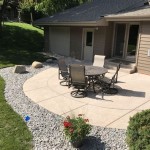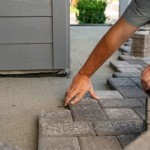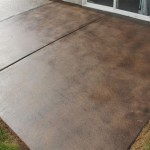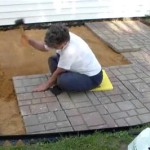How to Update an Old Concrete Patio
An aging concrete patio can detract from the overall curb appeal and usability of an outdoor living space. Cracks, discoloration, and general wear and tear are common issues that arise over time. Fortunately, various methods exist to update and revitalize an old concrete patio, restoring its aesthetic appeal and functionality. This article explores several techniques for breathing new life into an aging concrete patio, enabling homeowners to transform it into a stylish and inviting outdoor area.
Cleaning and Preparation: The Foundation for Success
Before embarking on any significant renovation project, thorough cleaning and preparation of the concrete surface are paramount. This ensures proper adhesion of any subsequent coatings or treatments and reveals the extent of any damage that needs addressing. Start by removing any furniture, potted plants, or other items from the patio area. Using a stiff-bristled brush or broom, sweep away loose debris, dirt, and leaves. For more stubborn dirt and grime, consider using a pressure washer. When pressure washing, exercise caution to avoid damaging the concrete surface. Hold the nozzle at a safe distance and use a wide-angle nozzle to prevent etching or gouging. If mold or mildew is present, apply a specialized concrete cleaner or a solution of diluted bleach and water. Allow the cleaner to dwell on the surface for the recommended time before scrubbing and rinsing thoroughly.
After cleaning, allow the patio to dry completely. This may take several hours or even a full day, depending on weather conditions. Once dry, carefully inspect the surface for cracks, chips, and other imperfections. These flaws must be addressed before proceeding with any further treatments. Small cracks can often be filled with a concrete patching compound. Follow the manufacturer's instructions for application, ensuring that the compound is properly mixed and applied using a trowel or putty knife. For larger cracks, it may be necessary to use a concrete crack filler specifically designed for wider gaps. Deep cracks or extensive damage may require professional repair to ensure structural integrity.
Once the patching compound or crack filler has cured, sand the repaired areas smooth to blend them seamlessly with the existing concrete surface. This creates a uniform surface for subsequent coatings or treatments. For optimal adhesion, consider etching the concrete surface with a concrete etching solution. This opens the pores of the concrete, allowing primers, sealers, or coatings to penetrate and bond more effectively. Always follow the manufacturer's safety precautions when using etching solutions, and wear appropriate protective gear, such as gloves and eye protection.
Resurfacing and Overlaying: A Fresh New Look
Resurfacing or overlaying an existing concrete patio offers a more dramatic transformation, effectively concealing imperfections and creating a completely new surface. Various resurfacing options are available, each with its unique characteristics and aesthetic appeal. A popular choice is a concrete overlay, which is a thin layer of cement-based material applied over the existing concrete. Overlays can be applied in a variety of textures and patterns, allowing homeowners to achieve a wide range of looks, from smooth and modern to textured and rustic. Stamped concrete overlays mimic the look of natural stone, brick, or tile, offering an affordable alternative to these materials.
Before applying a concrete overlay, it is essential to prepare the existing concrete surface properly. This involves cleaning, repairing any cracks or damage, and etching the surface to ensure proper adhesion. A bonding agent may also be applied to further enhance the bond between the overlay and the existing concrete. The overlay is then mixed according to the manufacturer's instructions and applied using a trowel or squeegee. For stamped concrete overlays, specialized stamps are used to create the desired pattern while the overlay is still wet. Once the overlay has cured, it is typically sealed with a concrete sealer to protect it from stains, moisture, and UV damage.
Another option for resurfacing an old concrete patio is to apply a self-leveling concrete compound. These compounds are designed to create a perfectly smooth and level surface, ideal for patios that have unevenness or significant surface imperfections. Self-leveling compounds are typically poured onto the prepared concrete surface and allowed to flow and self-level. Once cured, the surface can be left as is for a minimalist look or further treated with stains, sealers, or coatings to achieve the desired aesthetic. Epoxy coatings are another option for resurfacing, offering a durable and attractive finish. Epoxy coatings are resistant to chemicals, stains, and abrasions, making them ideal for high-traffic areas. They are available in a variety of colors and finishes, allowing homeowners to customize the look of their patio.
Staining and Sealing: Enhancing and Protecting the Existing Surface
For homeowners who prefer a more subtle update, staining and sealing an existing concrete patio can be an effective way to enhance its appearance and protect it from the elements. Concrete stains penetrate the concrete surface, creating a long-lasting and fade-resistant color. Unlike paints, which sit on the surface, stains become part of the concrete, resulting in a more natural and durable finish. Various types of concrete stains are available, including acid-based stains, water-based stains, and acrylic stains. Acid-based stains react chemically with the concrete, creating unique and variegated color patterns. Water-based stains offer a wider range of colors and are generally easier to apply. Acrylic stains provide a more opaque finish and are often used to create solid color designs.
Before applying a concrete stain, it is crucial to clean and prepare the concrete surface thoroughly. This involves removing any dirt, grime, and loose debris, as well as repairing any cracks or damage. The surface should also be etched to ensure proper stain penetration. Once the surface is prepared, the stain can be applied using a brush, roller, or sprayer. The application method will depend on the type of stain and the desired look. Multiple coats may be necessary to achieve the desired color intensity. After the stain has dried completely, it is essential to seal the concrete surface with a concrete sealer. A concrete sealer protects the stained surface from stains, moisture, and UV damage. It also enhances the color and provides a glossy or matte finish, depending on the type of sealer used.
Various types of concrete sealers are available, including acrylic sealers, polyurethane sealers, and epoxy sealers. Acrylic sealers are a cost-effective option that provides good protection against water and UV damage. Polyurethane sealers offer superior durability and resistance to abrasion and chemicals. Epoxy sealers provide the most durable and long-lasting protection, making them ideal for high-traffic areas. The choice of sealer will depend on the specific needs and desired look of the patio. When applying a concrete sealer, follow the manufacturer's instructions carefully. Apply the sealer in thin, even coats, avoiding pooling or puddling. Allow the sealer to dry completely before allowing traffic on the patio.
In addition to staining and sealing, other decorative treatments can be used to enhance the look of a concrete patio. These include stenciling, which involves using stencils to create patterns or designs on the concrete surface, and scoring, which involves cutting grooves into the concrete to create a textured or patterned look. These decorative treatments can be combined with staining and sealing to achieve a truly unique and personalized patio design.
Updating an old concrete patio requires careful planning and execution. By thoroughly cleaning and preparing the surface, addressing any damage, and choosing the appropriate resurfacing, staining, or sealing techniques, homeowners can transform their aging patios into stylish and functional outdoor living spaces. Regular maintenance, such as cleaning and resealing, will help to prolong the life of the updated patio and keep it looking its best for years to come.

Diy Ideas To Update Your Worn Out Concrete Patio Outdoor Backyards

Resurfacing A Concrete Patio For Budget Diy Makeover Fab Everyday

Say So Long To That Old Concrete Patio And Update Your Outdoor Space O Donnell Bros Inc

Diy Concrete Patio Makeover The Frugal South

How To Give Old Concrete Patio An Inexpensive Long Lasting Facelift Hometalk

Easy Concrete Patio Coverup Ideas The Garden Glove

9 Great Concrete Patio Ideas For A Makeover Remodelaholic

Inexpensive Ways To Cover A Concrete Patio

Make Your Old Concrete Patio Look Beautiful Again Direct Colors

How To Paint A Porch Floor With Concrete The Honeycomb Home
Related Posts








